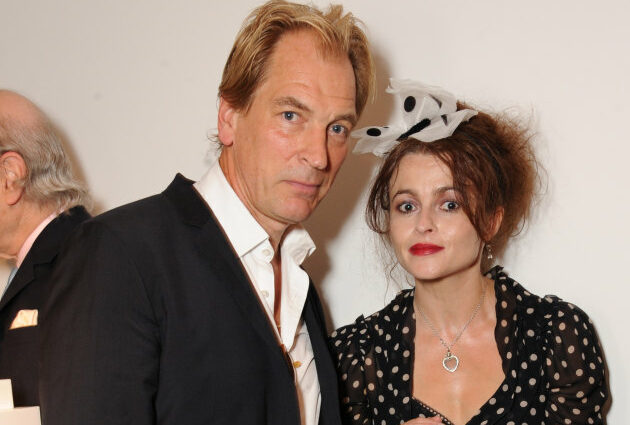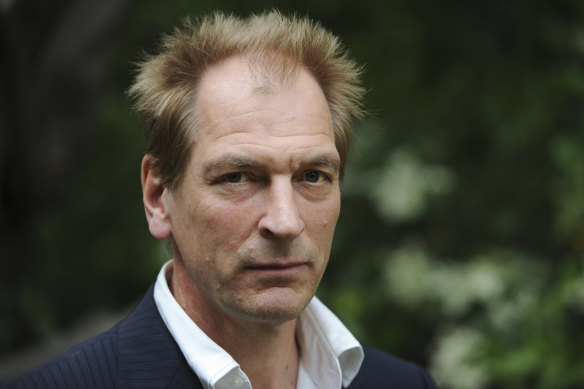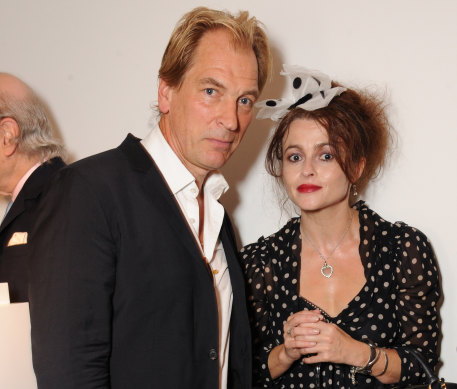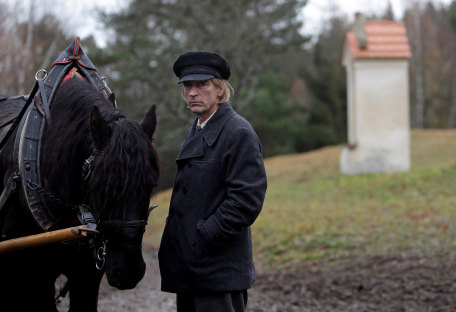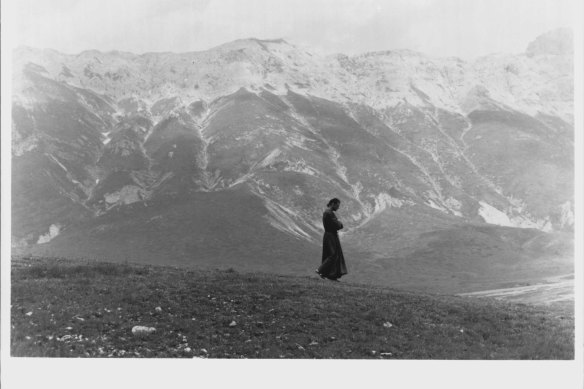Save articles for later
Add articles to your saved list and come back to them any time.
Julian Sands, a British actor who was best known for his portrayal of free-spirited passion in the Edwardian period piece A Room With a View, has been found dead more than five months after he went missing while hiking near Mount Baldy in California’s San Gabriel Mountains. He would have been 65.
Sands, an avid outdoorsman, was reported missing on January 13. Rescue teams undertook a ground search, which was soon suspended because of weather and the threat of avalanches. They continued surveilling the area by helicopter and drone.
Actor Julian Sands in 2013 in California.Credit: AP
More ground searches followed, and on June 24 hikers discovered human remains in the area where Sands had gone missing. The San Bernardino County Sheriff’s Department announced on June 27 that the remains had been positively identified as those of Sands and that the manner of death is still under investigation, pending further test results.
Sands was a mainstay of European and Hollywood movie sets for the past four decades and felt happiest, he once told the Guardian, when he was “close to a mountain summit on a glorious cold morning.”
With his blond locks and blue eyes, Sands could appear unconventionally handsome or icily sinister, a range that he embraced as he amassed more than 150 film and TV credits over his career.
He delivered his first notable screen performance as a photographer covering the Cambodian genocide in the 1984 drama The Killing Fields. His breakthrough came the following year in A Room With a View, an acclaimed 1985 film adaptation of E.M. Forster’s novel. Produced by Ismail Merchant and directed by James Ivory, the film was nominated for eight Academy Awards and won three.
Julian Sands and his A Room With a View co-star Helena Bonham-Carter.Credit: Getty
Playing the ebullient George Emerson, Sands appeared opposite Helena Bonham Carter as Lucy Honeychurch, an upper-crust Englishwoman on holiday in Florence in the early 1900s. With his unbridled verve – at one point, Lucy catches George unawares and in the nude, skinny-dipping with friends in a sylvan romp – he reveals to her what life might be like unconstrained by her high lace collars.
In one scene, backed by a soaring operatic aria, George and Lucy kiss in an Italian field under the scandalised eye of Lucy’s chaperone (Maggie Smith). That moment, Sands said he heard from fans, was “more of a turn-on for some people than an explicit sex scene could ever have been.”
After the success of A Room With a View, Sands moved to Hollywood, although he said he didn’t wish to become “a Hollywood actor.”
“I was looking for something exotic, things that took me out of myself,” he told the Guardian. “I think I found myself a little boring.”
Following A Room With A View, he tried an entirely different style of period piece, playing the English Romantic poet Percy Bysshe Shelley in Gothic (1986), director Ken Russell’s horror-film version of an actual encounter between writers including Shelley, his wife Mary, as played by Natasha Richardson, and Lord Byron, as played by Gabriel Byrne.
“James Ivory is like an Indian miniaturist, and Ken Russell is a graffiti artist,” Sands told the New York Times, reflecting on the differences between the two directors. “James Ivory is like an ornithologist watching his subjects with a pair of binoculars from afar, whereas Ken Russell is a big-game hunter filming in the middle of a rhino charge.”
Sands moved even further from Merchant-Ivory fare as the title character in Warlock (1989), about a 17th-century male witch transplanted to modern-day Los Angeles. “As the warlock, I am the prince of malevolence,” Sands told a reporter. “He’s so totally bad there is something attractive and pure about his evil.”
Throughout his life, Sands straddled the American and European film worlds, and he seemed equally at home in art house films and blockbusters.
‘My nerves were challenged in the death scene, when I had to have about 200 of these small spiders on my face … It was all real, no CGI.’
He ventured into the experimental with his appearance in Siesta (1987), about an American skydiver (Ellen Barkin) who awakens on the grass of an airport runway to find herself mysteriously dropped in Spain.
In Boxing Helena (1993), a “pitifully pervy piece of work,” as a Washington Post film critic described it, Sands played a surgeon who amputates the arms and legs of a woman who is the object of his desire.
In the more popular category, he appeared memorably as Dr. James Atherton, an entomologist, in Arachnophobia (1990), about a killer South American spider that invades the United States.
“The fortunate thing about ‘Arachnophobia’ is that I don’t have arachnophobia,” Sands told an interviewer years later, referring to the fear of spiders. “Although my nerves were challenged in the death scene, when I had to have about 200 of these small, little spiders on my face. … It was all real, no CGI. … Yeah. That was a memory.”
Julian Sands filming “Painted Bird” in the Czech Republic in 2017.Credit: Reuters
He said he found no conflict between the two poles of his work, the highbrow and the low.
“I don’t apologise to either camp. Though sometimes they feel I should,” he told the Guardian. “Quite a lot of films in Europe have depth and subtlety and nuance, which may or may not translate into a good movie. Some of the American films like Warlock … or Arachnophobia are much more like being in a cartoon. To play the character makes slighter demands on one’s emotion, intellect, imagination, but the demand on one’s technical skills is quite sharp.”
Sands was born in the town of Otley in West Yorkshire. According to the San Bernardino County Sheriff’s Department, his full name was Julian Richard Sands, and he was born January 4, 1958.
Sands’s father conducted agricultural soil surveys, and his mother, a secretary at a garage, was an amateur actress. Sands was still a child when she took him to see Laurence Olivier in a production of Shakespeare’s Richard III, sparking his interest in acting.
Julian Sands in “Night Sun” by the Taviani Brothers from Leo Tolstoy’s novel “Father Sergius”. Credit: Source unknown
Sands studied at the Royal Central School of Speech and Drama in London before embarking on his career. One of his first roles was in the British TV miniseries A Married Man, starring Anthony Hopkins as a tortured adulterer.
Even after A Room With a View, historical films maintained their pull on Sands. He played the 19th-century composer Franz Liszt in Impromptu (1991) and King Louis XIV of France in Vatel (2000). Thrillers and horror films, too, attracted him through his life; his more recent credits included The Girl With the Dragon Tattoo (2011), based on the novel by the Swedish writer Stieg Larsson.
Through his work in The Killing Fields, Sands formed an enduring friendship with American actor John Malkovich, who also appeared in the film. Malkovich directed the one-man play A Celebration of Harold Pinter, which premiered in 2011 at the Edinburgh Festival Fringe with Sands in the title role of the Nobel Prize-winning English playwright and poet.
Sands’s marriage to the Sarah Harvey ended in divorce. He was married in 1990 to Evgenia Citkowitz. He had a son from his first marriage, Henry, and two daughters from his second marriage, Natalya and Imogen, but a complete list of survivors was not immediately available.
The Washington Post
The Opinion newsletter is a weekly wrap of views that will challenge, champion and inform your own. Sign up here.
Most Viewed in World
From our partners
Source: Read Full Article
-
Wrestling star battles brain cancer for second time as he leaves for surgery
-
20 most common Covid symptoms as cases surge by 30% across the UK
-
Schoolgirls in tears after being ‘patted down’ over tight pants
-
Honeytrap gang leader who used girl to lure rival to death to be freed from jail
-
Drugged up Prince Harry claims he talked to a bin during coke and mushroom binge
